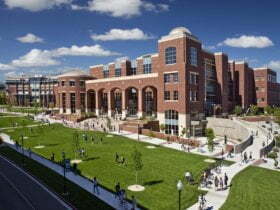Editor’s Note: Most of America’s maximum skilled instructors will retire in the following five years. The Baby Boomers live behind a nation of more novice educators. In 1988, an instructor most usually had 15 years of experience. Less than three a long time later, that number had fallen to just three years leading a classroom. The Atlantic’s “On Teaching” venture is crisscrossing us to talk to veteran educators. This tale is the 8th in our collection.
When Michelle Martin thinks again about her coaching profession, she identifies its place to begin as 2d grade—now not while her students were second graders, but while she was. Earlier this yr, sitting in her office complete with youngsters’ books at the University of Washington, Martin advised me that her first student became a classmate, a bit female whose circle of relatives had moved into Martin’s neighborhood in Columbia, South Carolina, and who “had had a turbulent youth.” Upon noting that her classmate was having a hassle reading, Martin instructed their trainer no longer to fear—she’d deal with it. Martin recollects a few specifics of her teaching approach, but her trainer later remarked to Martin’s mom, “She taught that infant to examine!”

Decades later, as a professor who makes a specialty of kids’ library services in the Information School at the University of Washington, Martin continues to be turning youngsters into readers, and her mission has elevated to instructing instructors and librarians about how to make college students of all backgrounds keen to explore books. Martin’s Day’s process is coaching graduate college students, most of them future librarians, approximately kids, and younger adult literature. (Her professorship, known as the librarian, grew to become loved children’s book writer Beverly Cleary.) Martin’s philosophy is that all youngsters can grow to be fans of books; however, it’s an educator’s activity to assist them in finding the memories in which they can see or imagine themselves.
In 2017, a study published using the American Library Association indicated that 87 percent of librarians were white in the United States. Meanwhile, the pool of American teachers is about 80 percent white, and kids’ literature as a style is likewise overwhelmingly written by using and about white humans. Yet only 1/2 of American children are white—and Martin has taken notice over time of the methods in which the whiteness of school libraries and classroom ebook collections can alienate college students of shade, ensuing in overlooked opportunities to foster a love of analyzing.
Despite the remaining shape of her career trajectory, Martin says she spent a terrific chew of time resisting the idea of becoming an educator. So Martin co-based Camp Read-a-Rama, a summertime application that started in South Carolina, moved with her when she relocated to Washington. She’s additionally relied on useful resources for librarians, coaching them to contain books by and about people of color in their libraries and tale times.
Her mother, father, and grandmother had been teachers, and Martin was hesitant to do anything she thought might be mindlessly falling in line. But she ended up teaching beside. After graduating from college as an English important in 1988, she desired a smash from faculty before pursuing a Ph.D., and they found a process as a doors educator near California’s Sequoia National Forest.
Upon accepting the function, “I needed to do some PR paintings with my mom,” Martin remembers. “She was like, ‘Black people had been looking to get out of the woods for [generations]!'” But Martin fell in love with outdoor education. She taught kids about animal existence cycles and the nighttime sky, having them write haiku out on the trail and examine songs Martin herself had written about a way to perceive exceptional kinds of animal poop. After years, Martin left and got a master’s in outdoor training. She spent the following years operating as a naturalist in South Carolina’s Sesquicentennial State Park, 10 minutes from where she grew up.
Martin went back to high school to earn her Ph.D. In kids’ literature in 1993. She began her schoolroom teaching career four years later. She ultimately ended up at Clemson University, a pass she welcomed because it intended living in her domestic nation of South Carolina. (Martin taught at Clemson for 12 years before taking over her modern role at the University of Washington in 2016.) At Clemson, she informed Rachelle D. Washington, a training professor she’d befriended, “approximately this concept I had of taking my [outdoor education] ardor and my children’s-lit ardor and placing them collectively,” Martin instructed me. “And she stated, ‘Let’s do it.'” In 2009, they launched Camp Read-a-Rama.
Camp Read-a-Rama has been held in libraries, churches, faculties, and less expensive housing complexes for previously homeless families; Martin’s ambitions are to “locate the kids who need to be there and ensure that they could have the funds for camp.” Kids who attend also get books to take home, as studies have tested how important it’s far too early for life literacy to have a domestic library.
Local instructors who hear about the program often reach out to Martin to recommend unique students who could benefit from attending. But children who want the greater help she delivered are everywhere. Several years ago, while the camp was still in South Carolina, she pulled into her driveway on a 100-diploma day while a few employees were repairing her roof.
“I heard, ‘Papa, Papa! Can I get out of the truck?'” Martin remembered. A little boy became ready in the vehicle, and when Martin approached, he advised her his grandpa had changed into the roof. “Papa and Grandma were elevating him, Dad turned into a prison, and they couldn’t find the money for childcare. So Papa had to take him to work.” Martin had him at Camp Read-a-Rama the subsequent Monday.
Martin emphasized that what she and her body of workers teach at Camp Read-a-Rama is much less reading and greater amusement in analyzing. In Martin’s experience, analyzing becomes a greater attractive prospect to children while “you placed them in an immersive environment wherein they’re surrounded through books that they prefer,” she stated. “You have been given an ebook that will suddenly become an activity: You examine approximately the moist dog, then perform it out on the degree. Otherwise, you’re out of doors splashing around like the wet canine did, for example.” Martin refers to this approach as “decreasing the space among books and lifestyles.”
Lauren Rizzuto, a former pupil and studies assistant of Martin’s at Clemson, worked with Camp Read-a-Rama in its early ranges and enjoys informing how she teaches now as an accessory professor of youngsters’ literature at Simmons University in Boston. “I kept a lot of that arms-on revel in mind once I turned into designing my path so that it wouldn’t be simply analyzing books in a vacuum,” she said.
In addition to teaching kids and graduate college students, Martin mechanically advises librarians who need their libraries to serve kids and families of color better. She has visible firsthand what she considers to be a perfect library setup: On a current visit to Australia, she visited a library and was greeted by “rows and rows and rows of [books in] all the languages of the individuals who could be visiting that library—motion pictures, magazines, from a lot of these unique international locations,” in addition to in the indigenous languages of the aboriginal human beings of the region. “What a welcome?” she recalled. “Structurally, it’s already pronouncing; You belong right here.”
But Martin thinks it’s crucial no longer to have books that function for folks who appear and sound like their young readers but to teach the one’s books, too. To make this point, she is keen on reading books to librarians, consisting of Derrick Barnes and Gordon C. James’s Crown: An Ode to the Fresh Cut, a children’s ebook about the power of a clever barbershop haircut to reinforce self-esteem, with illustrations that big-name younger black boys. She tells the librarians.
“You may not realize from experience [what some of the haircuts are], and a number of the children may not recognize, but you may do your homework and discover.” It’s okay, Martin provides in her workshops, for white educators to admit to youngsters that they’re no longer familiar with certain things that could come up in books for numerous readers. “You can research from children,” she stated, “and they can teach you numerous stuff if you’re inclined to pay attention.”













